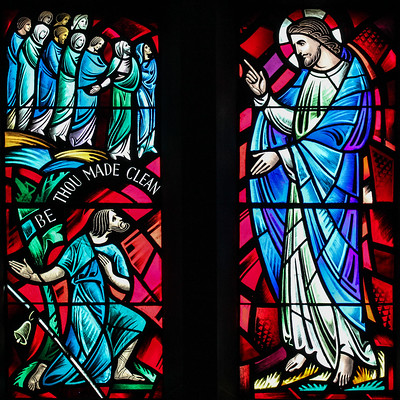First Reading: Leviticus 13:1-2,44-46
The Law regarding leprosy is given to Moses and Aaron.
Responsorial Psalm: Psalm 32:1-2,5,11
A prayer of contrition and confession for sin.
Second Reading: 1 Corinthians 10:31—11:1
Paul urges the Corinthians to imitate him as he imitates Christ.
Gospel Reading: Mark 1:40-45
Jesus cures a person with leprosy, who reports his cure to everyone.
Touching the Untouchable
Leprosy in biblical times covered a wide range of skin diseases from ringworm or psoriasis to what is today known as Hansen’s disease – a truly horrific condition which, if untreated, can lead to loss of fingers and toes and other deformities of the body. Fear of contagion forced victims to live outside the community and endure a much more severe form of isolation than that endured by the victims of the Covid-19 virus today. Lepers were treated as outcasts, pariahs, untouchables. Their miserable plight was made even worse by the ingrained belief that their disease was a punishment from God for sin. Thus, to their physical affliction was added the psychological and mental affliction of feeling rejected not only by society but even by God. As our first reading from the Book of Leviticus makes clear, a leper was declared ‘unclean’ by one of the priests, compelled to wear ‘his clothing torn and his hair disordered’, to ‘shield his upper lip and cry, “Unclean, unclean”, and to ‘live outside the camp’ (Lev 13:45-46). Moreover, Jewish Law forbade anyone from approaching or touching a leper under the pain of incurring ritual defilement. Hence the life of a leper at the time of Jesus was nothing short of a ‘living hell’. Death would have been preferable to living with leprosy
This context makes the story of Jesus’ cure of a leper in today’s gospel quite remarkable. First there is the extraordinary courage and faith of the leper. In spite of the frightful stigma he had to endure, he still has the courage to approach Jesus, trusting that he will accept and cure him. To come close to Jesus he had to risk the anger of the people around Jesus and the likelihood of been chased away with stones. With an exemplary combination of faith and humility he goes down on his knees before Jesus and pleads with him in words that must have wrung the very heart of Jesus: “If you want to, you can cure me” (Mk 1:40).
Even more extraordinary is the response of Jesus, especially the manner in which he cures the leper. Moved with compassion for the leper, he says: “Of course I want to. Be cured”. And then, with a gesture not only forbidden by the Mosaic Law but profoundly counter-cultural, he reaches out and touches the leper with his hand. This gesture – touching the untouchable – spoke more eloquently than any words could and brought spiritual as well as physical healing to the unfortunate man. It was a gesture of acceptance and empathy that restored the leper’s humanity and sense of self-worth as well as curing him: ‘At once the leprosy left him and he was cured’ (Mk 1:42).
One of the sad consequences of the Covid-19 pandemic is its proscribing the gesture of touch, in effect making lepers of us all. The sense of touch is at the core of what it means to be human. Far more than words, it conveys concern, empathy, support and affirmation. In his latest book, Let us Dream, Pope Francis reminds us that, while ‘social distancing is a necessary response to a pandemic, it cannot last without eroding our humanity…. The communication we most need is touch…. We yearn for the touch of those we love, which we must sometimes give up for their sakes and ours. Touch is a deeply human need’ (Let us Dream, 23). Pope Francis illustrates this truth from his personal experience. During his Wednesday audiences, he was often approached by blind children who wanted to touch his face with their hands so they could “see” the Pope.
The power of touch was brought home to me forty years ago when I was teaching in a seminary in Liberia, West Africa. Every week, with a small group of seminarians, I travelled to a nearby Leprosarium, bringing some food and leading a prayer service with the members of the Leper community. The highlight of the prayer service was always the kiss of peace, when all decorum was abandoned, and everyone went around shaking hands with everyone else – not the usual handshake with the person beside you that we are accustomed to in Ireland. [The leprosy was inactive so there was no risk of contagion.] At that moment the small assembly became alive and radiated a joy that was truly infectious, making a lasting impression on me. It taught me more about the message of Christ than many homilies.
As disciples of Jesus we are called, like St Paul, to model our lives on Christ, to reach out to others with compassion and love, especially to those who are rejected and stigmatised in any way. The recently published Government report on the Mother and Baby Homes has made us shamefully aware of the profoundly unchristian manner in which we (Church and State, priests and people) treated unfortunate girls who became pregnant outside marriage. As Archbishop Michael Neary of Tuam stated in his response to the Report, ‘when the Church is not serving with compassion, it is failing’.
The love of God impels us to imitate the example of Jesus and bring his compassionate and healing touch to the lepers of our time: the isolated, despised and broken women and men longing for acceptance and love.
So we pray: ‘Lord pour your Spirit into our hearts and make us effective instruments of your healing love in our world today’.
Michael McCabe SMA, February 2021
Click on the play button below to listen to an alternative homily from Fr Tom Casey SMA.
|
|

